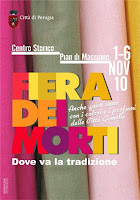Happy Thanksgiving from Umbra!
Today we’re thankful for Perugia. And knowing how quickly this last month will fly by for the Fall 2010 students, the Umbra staff have put together a list of Umbra’s Top Five Must-Do’s before you leave — so get out there and be thankful for all Perugia has to offer!
 5. Taste free chocolate at the Perugina factory.
5. Taste free chocolate at the Perugina factory.
Most of the Italian classes have toured the home of the world-famous chocolate and hazelnut baci, but if you missed out, pick up a bus ticket and go on your own for a free tour and tasting!
4. Celebrate the holidays  in Gubbio with the World’s Largest Christmas Tree.
in Gubbio with the World’s Largest Christmas Tree.
Every year since 1981 the Umbrian town of Gubbio lights up the world’s largest Christmas tree, stretching across the mountainside between the Basilica above and the town below. The tree will be lit for the first time this year at 6:30 pm on December 7th. Gubbio is easily reachable by a 1-hour bus ride from Piazza Partigiani (one-way ticket costs about 4.50 euro). Make a quick trip one evening after sunset or stay over in Gubbio for the night!
3. Walk through the “underground city,”  over the Roman aqueduct, and into the Duomo.
over the Roman aqueduct, and into the Duomo.
We walk past these landmarks around town everyday, but have you ever actually been inside? Perugia’s most interesting historical sites are all free and right here in the center: the Roman Aqueduct, the Etruscan Well, the Tower of Sant’Angelo, the Duomo, and the Rocca Paolina. Talk to Zach if you need help finding these spots.
 2. Eat Pasta alla Norcina, Torta con Salsiccia ed Erba, and Hot Chocolate from August Perusia!
2. Eat Pasta alla Norcina, Torta con Salsiccia ed Erba, and Hot Chocolate from August Perusia!
Pasta with Umbrian sausage and truffles, trypical Umbrian bread, and to-die-for hot chocolate… you can’t go home without trying these Perugia specialities. And while you’re at it, fresh olive oil, vino novello, and roasted chestnuts are all in season!
1. Ride the Ferris Wheel in Piazza Italia!
At the beginning of December each year a ferris wheel goes up in Piazza Italia with an incredible view out across the valley below — what could be a better way to remember Perugia? (And yes, this is a ferris wheel, despite the massive “Carousel” sign at the front. Oh, Italians…)





 of Italian-American cuisine during a conference in Florence. The conference, entitled “Italian Cultural Integration: Facts & Fiction,” was organized by SUNY Stony Brook and the Palazzi Florence Association for International Education. The aim of the conference was to introduce, focus on, and outline different perspectives that concern Italians as migrants from the past two centuries on and contemporary Italians in their country integrating with other ethnic groups.
of Italian-American cuisine during a conference in Florence. The conference, entitled “Italian Cultural Integration: Facts & Fiction,” was organized by SUNY Stony Brook and the Palazzi Florence Association for International Education. The aim of the conference was to introduce, focus on, and outline different perspectives that concern Italians as migrants from the past two centuries on and contemporary Italians in their country integrating with other ethnic groups.
 This year’s fall break coincided with Italy’s national holiday, falling on November 1st, , a day dedicated to honoring loved ones who’ve passed away. Locals here in Perugia celebrate the day amid family, friends and lots of food while outside of town near the stadium the annual fair is in full swing–complete with carnival rides, food and an enormous market called Fiera dei Morti (Fair of the Dead). A smaller market in the center of Perugia is set up and vendors are selling everything from homemade treats like strudel, cured meats and cheeses and handmade crafts. The fair goes on until November 6th.
This year’s fall break coincided with Italy’s national holiday, falling on November 1st, , a day dedicated to honoring loved ones who’ve passed away. Locals here in Perugia celebrate the day amid family, friends and lots of food while outside of town near the stadium the annual fair is in full swing–complete with carnival rides, food and an enormous market called Fiera dei Morti (Fair of the Dead). A smaller market in the center of Perugia is set up and vendors are selling everything from homemade treats like strudel, cured meats and cheeses and handmade crafts. The fair goes on until November 6th.